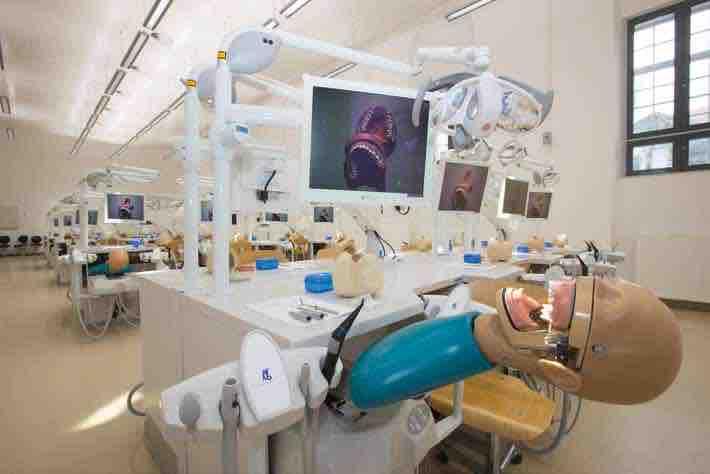
3 minute read
Speakers and Abstracts
Molar incisory hypomineralization: Where do conventional and where do digital therapy approaches make sense?
Univ.-Prof.in Dr.in med. dent. habil. Katrin Bekes, MME1 Prof. DDr. Norbert Krämer2
Advertisement
1University Clinic of Dentistry, Head of Clinical Division of Paediatric Dentistry, Vienna, Austria
2Justus-Liebig-Universität Gießen, Director, Gießen, Germany
Abstract
The treatment of children with molar incisor hypomineralization (MIH) is playing an increasingly important role in dental practice. It is a frequently encountered dental condition worldwide, affecting around 13% of children. MIH is defined as the hypomineralization of systemic origin of one to four permanent first molars, which is frequently associated with affected incisors. Affected teeth are more prone to caries and post-eruptive enamel breakdown and should be diagnosed and managed as soon as possible. Furthermore, tooth hypersensitivity is a common symptom in these patients. It is important to diagnose affected children at an early stage and to offer treatment that is appropriate with respect to the severity of the condition. The “Würzburg Concept” which was developed by an international working group with representatives from
German-speaking universities (Austria, Germany, Switzerland) can provide assistance here. The joint lecture by Prof. Bekes and Prof. Krämer will provide insights into the diagnostics and therapeutic possibilities of MIH, highlight conventional restoration techniques and discuss the potential to use the digital workflow.
Digitalization: Where are the real benefits?
Univ.-Prof. Dr. med. dent. Florian Beuer, MME Department of Prosthodontics, Geriatric Dentistry and Craniomandibular Disorders, Director, Charité Berlin, Germany
Abstract
The transition into the digital age has are real benefits for our patients and our profession? Do our restorations last our treatment? Some of these questions will definitely be answered with “no”.
Extraordinary Full Professor Dr. Roeland De Moor, DDS, PhD, MSc
Head of the Research Cluster of Endodontics, Department of Oral Health Sciences, Ghent University, Belgium Director of the three-year Master after Master programme in Endodontics, Ghent University, Belgium
Adjunct Professor at the Medical University of Vienna, Austria, Ghent Dental Laser Centre
Abstract
Laser-activated irrigation (LAI) with Erbium lasers was marketed in 2009. This approach is based on the creation of expanding and imploding cavitation bubbles in the irrigation solution, resulting in three-dimensional spreading and agitation of the fluid in the root canal system. Hence, it is a powerful approach to cleaning and disinfecting root canals. From activation with the fiber in the root canal, we evolved to the use of the laser tip positioned in the pulp chamber. Originally, the fiber was positioned in the root canal and moved up and down. Together with the development of super short pulses (50 µsec), a new approach was launched in 2013. A double-pulse modality was introduced in 2018 with the goal to enhance the disinfecting and activating efficacy of SSP (super short pulse) laser-assisted activation (PIPS). This SWEEPS (Shock Wave Enhanced Emissi- on Photoacoustic Streaming) approach consists of delivering a subsequent laser pulse into the liquid at an optimal time when the initial bubble is in the final phase of its collapse. In this presentation, the differences between the different approaches are clarified, the impact on and differences in their efficacy are demonstrated with high-speed imaging, and new insights on how LAI interacts with the biofilm are shared.
Is there an advantage of digital processing of implant abutment in prevention of peri-implant disease?
Ao. Univ.-Prof. DDr. Gabor Fürst University Clinic of Dentistry, Clinical Division of Periodontology, Vienna, Austria
Abstract
In recent years, the evidence of a relationship between restorative design factors and peri-implant health has increased and, especially, the structure of implantabutment junction and mucositis and periimplantitis. In this presentation, the background and clinical aspects of the concept of one-abutment at one time will be highlighted. One special issue is the prevention of peri-implant disease. Factors that can influence the inflammatory reaction of the peri-implant tissue will be discussed, especially focussing on biomarkers associated with inflammation and tissue destruction in peri-implant crevicular fluid (PICF) of implants. Finally, a case report will show the procedures used to scan, design and produce the individual abutment for dental implant.
Current cross-sectional imaging of the jaw
Ao. Univ.-Prof. Dr. André Gahleitner University Clinic of Dentistry, Clinical Division of Radiology, Vienna, Austria
Abstract
By ending analog imaging techniques and and shifting towards digital imaging, Dental Radiology has made huge advances without sacrificing well-established examination methods. With the advent of computed tomography in dental radiology, additional cross-sectional imaging techniques have recently become more and more available in dentistry as well.
Hence, it is helpful to introduce the most important ones and provide an overview. More specifically, you will learn about the diagnostic possibilities of:
• Selective-Slice Panoramic X-ray
• Dental Computed Tomography (dCT)
• Cone Beam Computed Tomography (CBCT)
• Sonography of the jaw
• Dental Magnetic Resonance Imaging (dMRI)
None of these techniques is ”better“ or ”worse“ than the other, but rather has its own strengths or weaknesses for answering a specific question or for using in an application. This presentation will give an overview of the benefits, risks and accompanying caveats when using them in the jaw region.


